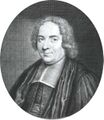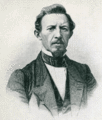Template:Selected anniversaries/December 23: Difference between revisions
Jump to navigation
Jump to search
No edit summary |
No edit summary |
||
| (2 intermediate revisions by the same user not shown) | |||
| Line 45: | Line 45: | ||
||1939: Ludwig Hopf dies ... theoretical physicist who made contributions to mathematics, special relativity, hydrodynamics, and aerodynamics. Pic: https://www.geni.com/people/Prof-Dr-Ludwig-Hopf/6000000003495136149 | ||1939: Ludwig Hopf dies ... theoretical physicist who made contributions to mathematics, special relativity, hydrodynamics, and aerodynamics. Pic: https://www.geni.com/people/Prof-Dr-Ludwig-Hopf/6000000003495136149 | ||
||1944: The Great Papago Escape was the largest Axis prisoner-of-war escape to occur from an American facility during World War II. On the night of December 23, 1944, twenty-five Germans tunneled out of Camp Papago Park, near Phoenix, Arizona, and fled into the surrounding desert. All of the escapees were eventually recaptured without bloodshed over the next few weeks, and although most were detained within Maricopa County, a few nearly made it to the border of Mexico, which is about 130 miles south of the camp. Pic. | |||
||1947: The transistor is first demonstrated at Bell Laboratories. | ||1947: The transistor is first demonstrated at Bell Laboratories. | ||
||1949: Arthur Eichengrün dies ... chemist, materials scientist, and inventor. He is known for developing the highly successful anti-gonorrhea drug Protargol, the standard treatment for 50 years until the adoption of antibiotics, and for his pioneering contributions in plastics. Pic. | ||1949: Arthur Eichengrün dies ... chemist, materials scientist, and inventor. He is known for developing the highly successful anti-gonorrhea drug Protargol, the standard treatment for 50 years until the adoption of antibiotics, and for his pioneering contributions in plastics. Pic. | ||
| Line 58: | Line 58: | ||
||1968: The 82 sailors from the USS ''Pueblo'' are released after eleven months of internment in North Korea. | ||1968: The 82 sailors from the USS ''Pueblo'' are released after eleven months of internment in North Korea. | ||
||1971: Hugh Rose Foss born ... cryptanalyst. At Bletchley Park during World War II he made significant contributions both to the breaking of the German Enigma code and headed the section tasked with breaking Japanese Naval codes. Pic search | ||1971: Hugh Rose Foss born ... cryptanalyst. At Bletchley Park during World War II he made significant contributions both to the breaking of the German Enigma code and headed the section tasked with breaking Japanese Naval codes. Pic search. | ||
||1972: Andrei Tupolev dies ... engineer, designed the Tupolev Tu-95 and Tupolev Tu-104. Pic. | ||1972: Andrei Tupolev dies ... engineer, designed the Tupolev Tu-95 and Tupolev Tu-104. Pic. | ||
| Line 71: | Line 71: | ||
||1989: Richard Rado dies ... mathematician whose research concerned combinatorics and graph theory. In graph theory, the Rado graph, a countably infinite graph containing all countably infinite graphs as induced subgraphs, is named after Rado. He rediscovered it in 1964 after previous works on the same graph by Wilhelm Ackermann, Paul Erdős, and Alfréd Rényi. Pic. | ||1989: Richard Rado dies ... mathematician whose research concerned combinatorics and graph theory. In graph theory, the Rado graph, a countably infinite graph containing all countably infinite graphs as induced subgraphs, is named after Rado. He rediscovered it in 1964 after previous works on the same graph by Wilhelm Ackermann, Paul Erdős, and Alfréd Rényi. Pic. | ||
||1992: Robert Marshak dies ... American physicist dedicated to learning, research, and education. Pic. | |||
||2001: Donald Clayton Spencer dies ... mathematician, known for work on deformation theory of structures arising in differential geometry, and on several complex variables from the point of view of partial differential equations. Pic: https://www.geni.com/people/Donald-Spencer/6000000000566571886 | ||2001: Donald Clayton Spencer dies ... mathematician, known for work on deformation theory of structures arising in differential geometry, and on several complex variables from the point of view of partial differential equations. Pic: https://www.geni.com/people/Donald-Spencer/6000000000566571886 | ||
| Line 79: | Line 81: | ||
||December 23 is the fictional date of the [[Zendian problem (nonfiction)|Zendian problem]], a US Army cryptography training exercise involving 375 radio messages said to have been intercepted on December 23 by the US Army contingent of a United Nations force landed on the fictional island of Zendia in the Pacific Ocean. | ||December 23 is the fictional date of the [[Zendian problem (nonfiction)|Zendian problem]], a US Army cryptography training exercise involving 375 radio messages said to have been intercepted on December 23 by the US Army contingent of a United Nations force landed on the fictional island of Zendia in the Pacific Ocean. | ||
</gallery> | </gallery> | ||
Latest revision as of 17:30, 7 February 2022
1722: Mathematician and academic Pierre Varignon dies. He simplified the proofs of many propositions in mechanics, adapted Leibniz's calculus to the inertial mechanics of Newton's Principia, and treated mechanics in terms of the composition of forces.
1822: Inventor and engineer Wilhelm Bauer born. He will design and invent submarines.
1933: Mathematician Rikitarō Fujisawa dies. During the Meiji era he was instrumental in reforming mathematics education in Japan and establishing the ideas of European mathematics in Japan.


